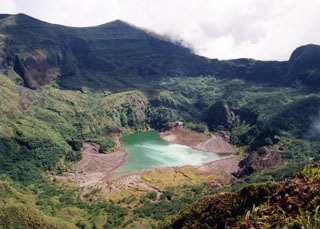Report on Awu (Indonesia) — 15 June-21 June 2016
Smithsonian Institution / US Geological Survey
Weekly Volcanic Activity Report, 15 June-21 June 2016
Managing Editor: Sally Sennert.
Please cite this report as:
Global Volcanism Program, 2016. Report on Awu (Indonesia) (Sennert, S, ed.). Weekly Volcanic Activity Report, 15 June-21 June 2016. Smithsonian Institution and US Geological Survey.
Awu
Indonesia
3.689°N, 125.447°E; summit elev. 1318 m
All times are local (unless otherwise noted)
PVMBG reported that the number of earthquakes at Awu had risen significantly on 11 May and remained elevated through 14 May; a downward trend in seismicity became evident on 21 May. Earthquake hypocenters were located at depths between 1 and 2 km. The Alert Level was lowered to 2 (on a scale of 1-4) on 14 June; residents and tourists were advised to stay 4 km away from the crater.
Geological Summary. The massive Gunung Awu stratovolcano occupies the northern end of Great Sangihe Island, the largest of the Sangihe arc. Deep valleys that form passageways for lahars dissect the flanks of the volcano, which was constructed within a 4.5-km-wide caldera. Powerful explosive eruptions in 1711, 1812, 1856, 1892, and 1966 produced devastating pyroclastic flows and lahars that caused more than 8000 cumulative fatalities. Awu contained a summit crater lake that was 1 km wide and 172 m deep in 1922, but was largely ejected during the 1966 eruption.
Source: Pusat Vulkanologi dan Mitigasi Bencana Geologi (PVMBG, also known as CVGHM)

